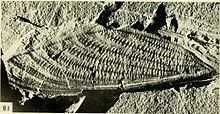Palaeontinoidea
| Palaeontinoidea Temporal range: Upper Permian to Middle Cretaceous | |
|---|---|
 | |
| Fossil forewing of Mesogereon superbum | |
| Scientific classification | |
| Kingdom: | Animalia |
| Phylum: | Arthropoda |
| Class: | Insecta |
| Order: | Hemiptera |
| Suborder: | Auchenorrhyncha |
| Infraorder: | Cicadomorpha |
| Superfamily: | †Palaeontinoidea Handlirsch, 1906 |
| Families | |
|
See text | |
Palaeontinoidea is an extinct superfamily of cicadomorphs. It contains three families.[1]
Description
Palaeontinoids were (usually large) cicada-like insects that existed from the Upper Permian to the Middle Cretaceous (around 260.4 to 112.0 million years ago).
Subdivisions
The three families classified under Palaeontinoidea, along with their age range and collection sites, are the following:
- Mesogereonidae Tillyard, 1921
- Upper Triassic; Australia and South Africa. Contains two monophyletic genera.[2]
- Dunstaniidae Tillyard, 1916
- Upper Permian to Lower Jurassic; South Africa, Australia, France, Central Asia, and China.[2][3]
- Palaeontinidae Handlirsch, 1906
- Upper Triassic to Middle Cretaceous; Brazil, China, Russia, Germany, the Transbaikal region, Tajikistan, Turkmenistan, Kyrgyzstan, Kazakhstan, Spain, and the United Kingdom. Contains around 30 to 40 genera and about a hundred species.[2]
See also
| Wikimedia Commons has media related to Palaeontinoidea. |
- Prehistoric Lepidoptera
- Prehistoric insects
References
- ↑ Boris B. Rohdendorf & Donald Ray Davis, ed. (1991). Fundamentals of paleontology: Arthropoda, Tracheata, Chelicerata. Volume 9. Smithsonian Institution Libraries and the National Science Foundation. p. 220–224.
- ↑ 2.0 2.1 2.2 Bo Wang, Haichun Zhang, & Jacek Szwedo (2009). "Jurassic Palaeontinidae from China and the Higher Systematics of Palaeontinoidea (Insecta: Hemiptera: Cicadomorpha)". Palaeontology (The Palaeontological Association) 52 (Part 1): 53–64. doi:10.1111/j.1475-4983.2008.00826.x.
- ↑ Fabrice Lefebvre, André Nel, Francine Papier, Léa Grauvogel-Stamm, & Jean-Claude Gall (1998). "The First 'Cicada-like Homoptera' from the Triassic of the Vosges, France" (PDF). Palaeontology (The Palaeontological Association) 41 (Part 6): 1195–1200. Retrieved July 21, 2011.